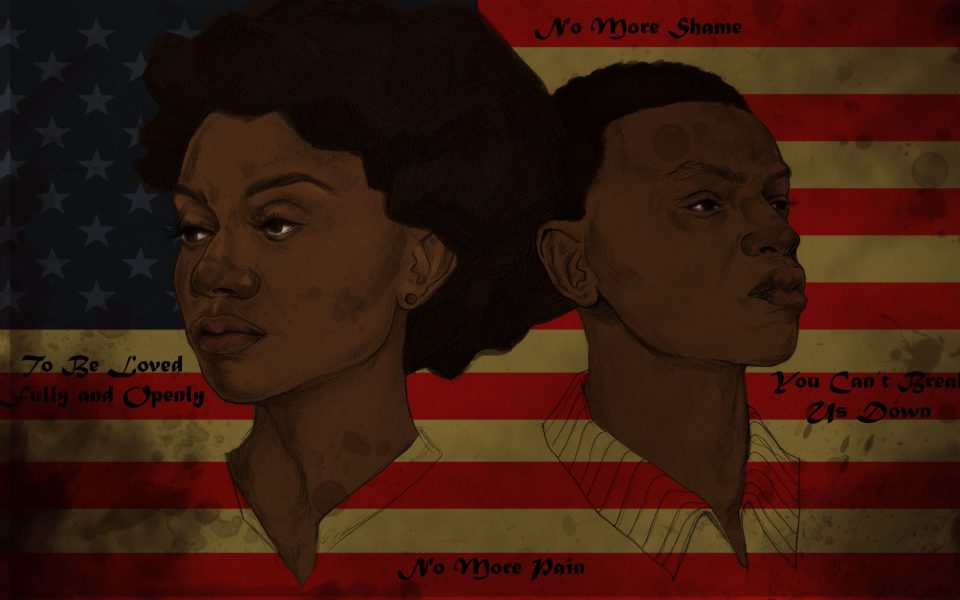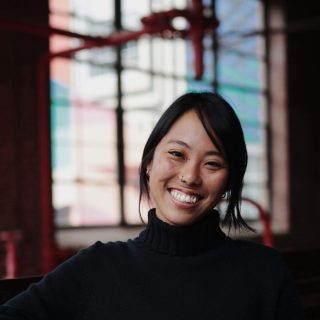Featured image: The African American flag by Ryan Oakley (courtesy photo)
Phoenix floats in the air, the ends of her hair crackling off into space like lightning. Her eyes glow brightly while her right hand carefully wields a smoky, winged figure rising out of the ashes. And while the drawing exists only in ink and is thus deprived of color, this Phoenix is Black. She’s the same, but markedly different.
In a different post, artist Ryan Oakley chooses Magik, another X-Men mutant, to race flip. Gone are her straight, blond tresses, long, thick locs in their stead.
“I wanted to only reimagine white characters,” says Oakley of the work she created for “Blacktober,” a month in which Black creatives celebrate fandom through art. “I didn’t want to do other characters of color because they are already limited as well.”
-

Phoenix by Ryan Oakley (courtesy image) -

Nurse Joy (courtesy image)
While the pieces Oakley chooses reference characters from pop culture, much of her work could be seen as self-portraiture, as an artistic extension of herself. In a drawing of a Black Marceline, a vampire character picked out of “Adventure Time,” Oakley infuses a sense of rock and edge, an aspect of her personality that she lets fly in her activism and outspokenness. In another, she casts Nurse Joy, the primary caregiver in the Pokémon world, as a Black woman with voluminous pink hair, perhaps drawing from her own experience during med school. Her characters might be farfetched, but they act as a way of infusing herself and her Blackness into a cultural world that doesn’t prioritize people who look like her.
“I wanted them to be race-flipped but to also choose characters that you wouldn’t normally see Black people in,” explains Oakley, who grew up in Greensboro. “Like a metalhead or a punk…. You don’t see Black women portrayed in those ways.”

Oakley started drawing when she was just a kid. In grade school, she would copy the cartoons she watched on TV like the little doodles out of the “Lizze McGuire” show or on “Spongebob Squarepants.” Soon, she graduated to drawing Black characters, ones that had the same melanin-rich skin tones that she existed in. Sometimes she drew herself or her family members.
“I remember one time I did a drawing of my mom in her work clothes,” Oakley says. “She still has it to this day.”
These days, Oakley, 26, has elevated her skills of drawing portraits to create commissions for national organizations and brands. In November 2018, her piece for the Women’s March featuring a Black female boxer with tight braids wrapping her right hand in the American flag was chosen as one of 50 from more than 1,000 submissions. In March of that year, Oakley created an image of Winter BreeAnne, a student activist who helped organize a national student walkout to protest gun violence, that went viral and was shared by celebrities. Last summer, Oakley created a series of portraits for Lifetime of famous women of color like Selena and Dolores Huerta. But her favorite piece was an image of Sandra Oh, she says.
“I love her in Killing Eve!” Oakley says.
The images are bright, the women front and center on top of colorful, cloudy and celestial backgrounds. In another piece for Lifetime, Oakley depicted mothers whose Black children have been killed by the police. Like the portraits of Oh and Selena, the images are colorful and full of life.
“I wanted them to have a lot of color and be vibrant,” she says. “I didn’t want them to be dowdy, for it to be a sad image.”
In the piece, Oakley depicts Tamika Palmer, Sybrina Fulton, Geneva Reed-Veal, Lezley McSpadden and Gwen Carr, each name floating under the portrait in a banner. Initially she says that Lifetime wanted to include the women’s children’s names too, but that Oakley pushed back on the idea and told them that if they wanted to honor the women, they should do just that.
“You know, like ‘Say their names,’” she says. “There was a moment where I had to get us in the right direction. I had to ask, ‘What is it that we want to say with this piece?’ If we’re representing Black women, a lot of these women have voices in their own right…. What happened to their sons is terrible, but we know their names. We don’t know these mothers’ names.”

Looking forward, Oakley hopes to use her skills to create her own comic book full of diverse, multidimensional Black characters that don’t have to draw inspiration from a white counterpart.
“My idea going into [Blacktober] was to show how there is a plethora of white characters,” Oakley says. “And the only reason why they’re not Black is because the creators are more than likely white. It was to show how important it is to have Black voices behind the scenes so that authentic Black characters are made.”
Oakley knows it’s going to be a challenge breaking through the predominantly white industry.
“I think a lot of Black artists get easily disillusioned with the fact that if you’re not white it’s going to be hard to break into comics,” she says. “If you’re not exceptional, it’s hard and that’s not fair, for Black people to have to be exceptional. I feel like Black artists have to be perfect from the jump.”
Still, she says she’s going to keep working at it because it’s what she’s good at and it’s what feels most authentic to her.
“I think I want to continue with creating in my own lane and if some big name wants to pick me up, I’ll go from there,” she says. “Just go after it.”
To learn more about Ryan and her art, visit her Instagram at @ryanoakleyart.
Join the First Amendment Society, a membership that goes directly to funding TCB‘s newsroom.
We believe that reporting can save the world.
The TCB First Amendment Society recognizes the vital role of a free, unfettered press with a bundling of local experiences designed to build community, and unique engagements with our newsroom that will help you understand, and shape, local journalism’s critical role in uplifting the people in our cities.
All revenue goes directly into the newsroom as reporters’ salaries and freelance commissions.




Leave a Reply